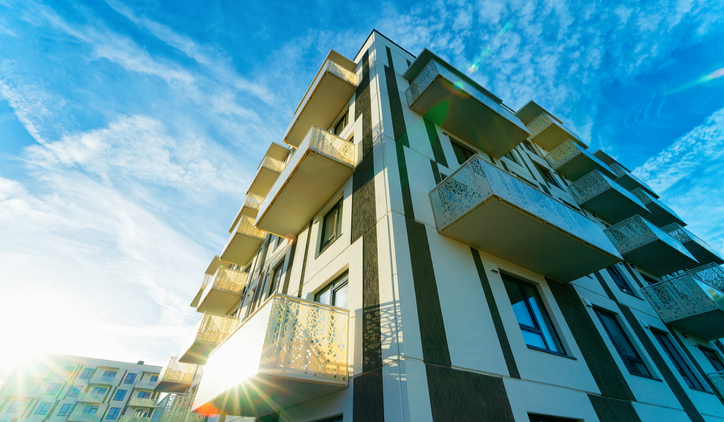Multi-family is a classification of housing that encompasses any building or property where multiple separate units are available for residential lease to tenants. Common examples include apartment buildings, condo buildings, and triplexes and quadplexes. As an investment asset, multi-family real estate has the ability to offer steady cash flow, property appreciation, substantial tax benefits, and a counter-cyclical resistance to recessionary periods.
Multi-Family Property Types
Let's take a quick look at some of the major categories of multi-family properties.
Condominium Buildings
Condominium or "condo" buildings are a type of multi-family ownership where there are individually owned units, and co-ownership among all residents/owners of common areas and systems, like the electrical system, building plumbing, interior and exterior building lighting, pools, building lobbies, etc.
Apartment Buildings
These are buildings with multiple apartments that are wholly owned by one entity, who then rents out each apartment in monthly or yearly leases. They range in size from a couple of units, all the way up to gleaming towers with hundreds, or even thousands of units in dense urban areas.
Duplex/Triplex/Quadplex
For most investors, a duplex is the most accessible multi-family asset. These properties are one building that is divided into two separate and individual living areas, generally right next to each other. Each unit has a separate entrance, and there are no shared areas for residents. Buildings with three or four units are called triplexes or quadplexes.
Townhome/Townhouse
These are homes with shared walls, but separate entrances. They are typically constructed in a row, with no set limit. Some townhome construction consists of one unit on top of another, with a private door for each unit.
There are many other different types and sub-types of multi-family property, but the vast majority most investors will encounter will come from one of the four above mentioned types.
Multi-Family Properties as an Investment Vehicle
There are significant investment opportunities within the multi-family space. Retirement savers and other investors are drawn to this asset class and property type for a few reasons.
Stable Cash Flow
Multi-family properties provide regular income in the form of monthly rent payments from tenants. The average lease tends to be one year, which locks in the market rate for the unit for that period. Other commercial property types, like industrial, manufacturing, and restaurants, tend to have much longer lease periods, which can lead to rents falling below prevailing rates. When leases are renewed, multi-family owners can increase rents to market levels, which allows that income stream to grow with changing circumstances.
If you are financing a property, you can use the positive cash flow from a multi-family property to obtain lent capital for further acquisitions, and build up your portfolio by leveraging that cash flow as an asset, separate from the obvious benefits of having monthly rent payments from tenants. Financing multi-family properties in this manner is riskier than purchasing with cash or minimizing outside funding, but it also potentially yields far greater rewards.
Asset Appreciation
Over the long-term, property appreciation and investments in real estate assets tend to generate similar returns, or slightly higher returns in the case of managed real estate, when compared to traditional equity investments. Property appreciation is a huge factor in that rate of return. While a multi-family building generates regular income through leases, many investors may also see substantial gains in the value of that property, especially over the long term.
Tax Benefits
Real estate is among the most tax-advantaged asset classes. Always consult with a tax professional to understand the impact for you before making any investment. There are numerous local, state, and federal programs and regulations that allow real estate investors to defer, or even write-off completely substantial portions of their tax bill. These include:
Depreciation
The IRS views multi-family property as a depreciating asset. This means that you can deduct that depreciation from your annual taxable income. The amount you can deduct is determined by the IRS depreciation table and the MACRS class length of the subject property. If a multi-family property is classified as residential real estate, the depreciation schedule lasts for 27.5 years- this means you can deduct 1/27.5 of the value of the property each year. The depreciation amount usually includes the building cost plus renovation, but not the value of the underlying land.
Interest Deduction
If you finance the acquisition of a multi-family property, you can deduct the cost of interest payments made on that loan during the construction period. Writing off interest from taxable income can improve your total cash flow through reducing tax payments. If you pay for improvements or daily operations for the property using loans or credit cards, you may also be able to deduct that interest from taxable income.
Federal, State, and Local Incentives
Many government programs aim to encourage development in under-served and low-income areas, and many of these programs can be taken advantage of by savvy multi-family investors. Common iterations include low-income tax credit housing deductions, Opportunity Zone benefits, and a plethora of local programs where cities and counties work with developers to create new housing, including multi-family properties.
Counter-cyclical Resistance to Economic Recessions
We are in the tenth year of an unprecedented economic expansion- which leads many investors to question when the shoe is going to drop. This can be particularly worrisome for retirement savings nearing the time when they need to access their investment accounts. Historically, multi-family properties have fared very well during recessionary periods. While overextended homeowners may lose their homes, they will still need a place to stay- which means that even if the housing market tanks, rental demand will likely stay strong. When the entire economy is falling apart, people can skimp on luxuries, but they cannot afford to skimp on basics like food, shelter, transportation, etc.
The Breakdown
There are many things to consider before investing in a multi-family property. Despite all of the positive qualities of the asset class, like any investment, due diligence is vital. Favorable tax policy and cash flow benefits won't make a bad investment into a good one- so treat any potential multi-family acquisition with the same rigorous vetting as you would any other investment asset.



